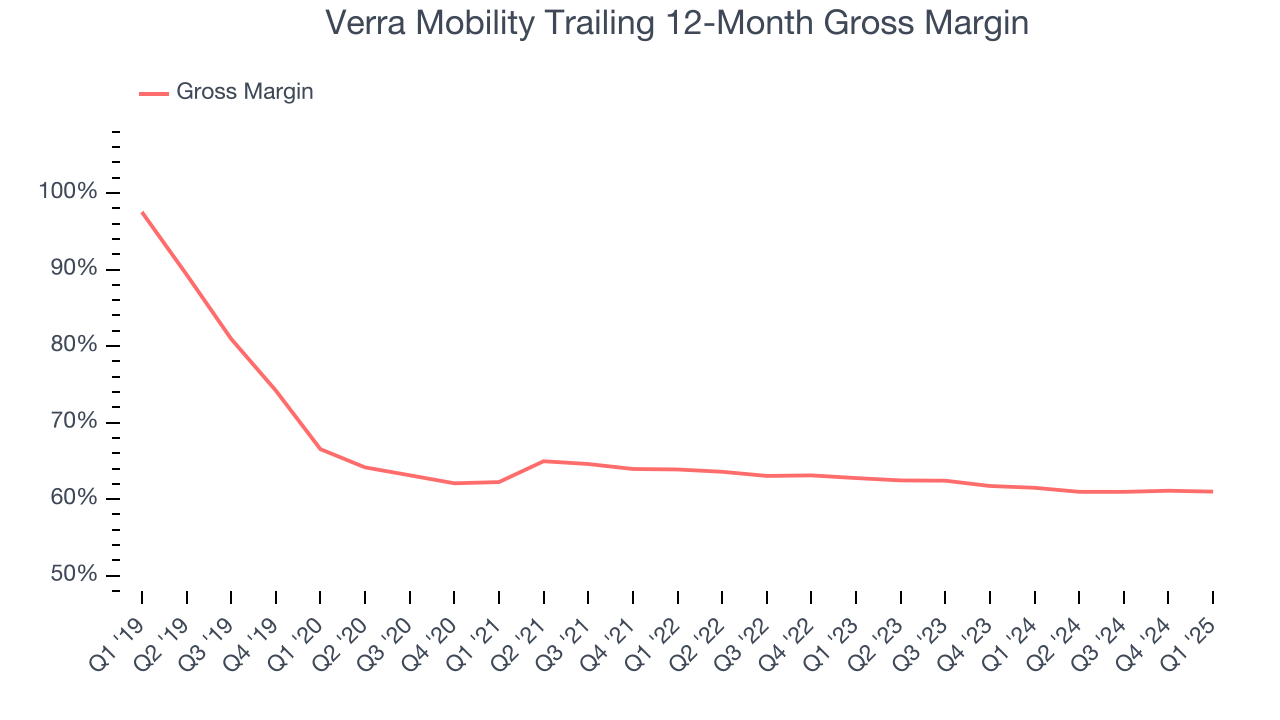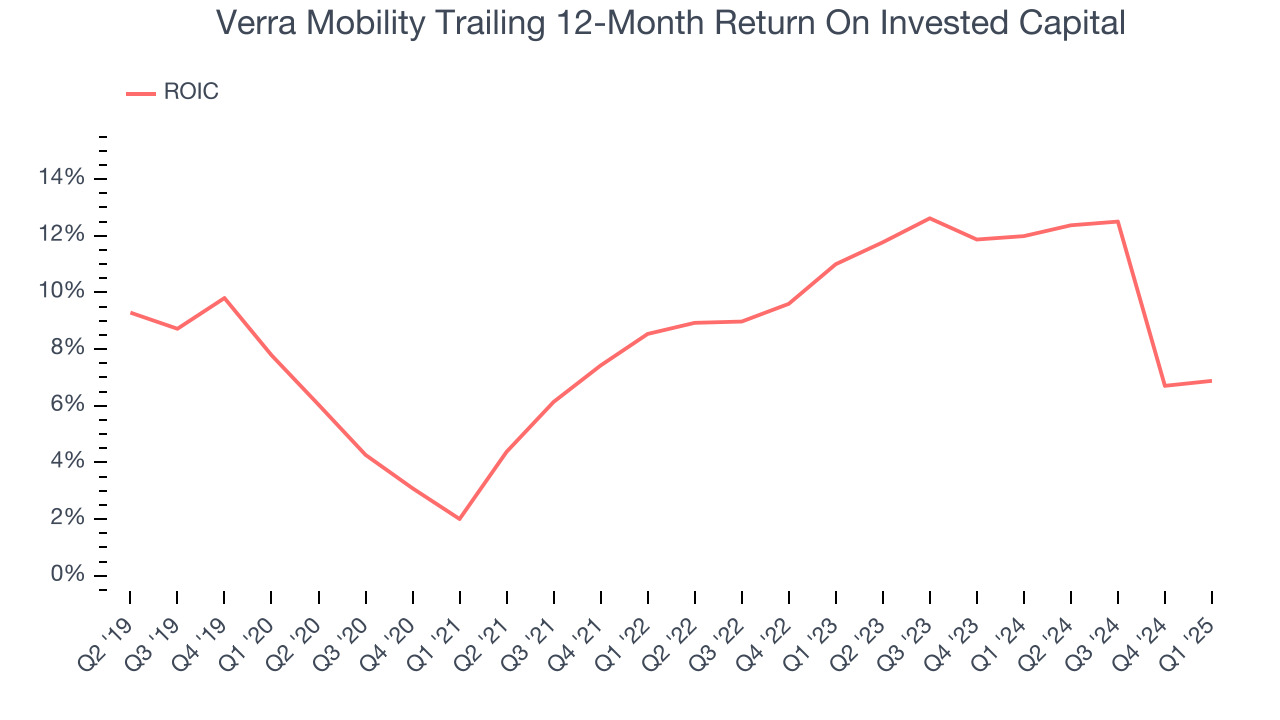
Verra Mobility (VRRM)
We’d invest in Verra Mobility. Its marriage of growth and profitability makes it a financial powerhouse with attractive upside.― StockStory Analyst Team
1. News
2. Summary
Why We Like Verra Mobility
Aiming to wrap technology and data around a historically manual and paper-based industry, Verra Mobility (NYSE:VRRM) is a leading provider of smart mobility technology to address tolls and violations, title and registration services, as well as safety and traffic enforcement.
- Offerings are difficult to replicate at scale and lead to a best-in-class gross margin of 62.1%
- Excellent operating margin highlights the strength of its business model, and its operating leverage amplified its profits over the last five years
- Robust free cash flow profile gives it the flexibility to invest in growth initiatives or return capital to shareholders, and its improved cash conversion implies it’s becoming a less capital-intensive business


We see a bright future for Verra Mobility. The price looks fair based on its quality, so this could be an opportune time to buy some shares.
Why Is Now The Time To Buy Verra Mobility?
High Quality
Investable
Underperform
Why Is Now The Time To Buy Verra Mobility?
Verra Mobility is trading at $25.53 per share, or 18.7x forward P/E. The valuation multiple is below many companies in the industrials sector. We therefore think the stock is a good deal for the fundamentals.
Entry price matters much less than business quality when investing for the long term, but hey, it certainly doesn’t hurt to get in at an attractive price.
3. Verra Mobility (VRRM) Research Report: Q1 CY2025 Update
Traffic solutions company Verra Mobility (NYSE:VRRM) reported Q1 CY2025 results exceeding the market’s revenue expectations, with sales up 6.4% year on year to $223.3 million. The company expects the full year’s revenue to be around $930 million, close to analysts’ estimates. Its non-GAAP profit of $0.30 per share was 4.5% above analysts’ consensus estimates.
Verra Mobility (VRRM) Q1 CY2025 Highlights:
- Revenue: $223.3 million vs analyst estimates of $217 million (6.4% year-on-year growth, 2.9% beat)
- Adjusted EPS: $0.30 vs analyst estimates of $0.29 (4.5% beat)
- Adjusted EBITDA: $95.44 million vs analyst estimates of $92.24 million (42.7% margin, 3.5% beat)
- The company reconfirmed its revenue guidance for the full year of $930 million at the midpoint
- Management reiterated its full-year Adjusted EPS guidance of $1.33 at the midpoint
- EBITDA guidance for the full year is $415 million at the midpoint, in line with analyst expectations
- Operating Margin: 25.7%, in line with the same quarter last year
- Free Cash Flow Margin: 18.7%, up from 9.6% in the same quarter last year
- Market Capitalization: $3.89 billion
Company Overview
Aiming to wrap technology and data around a historically manual and paper-based industry, Verra Mobility (NYSE:VRRM) is a leading provider of smart mobility technology to address tolls and violations, title and registration services, as well as safety and traffic enforcement.
Verra Mobility was originally established as a traffic enforcement technology business. Today, it offers products addressing smart mobility technology including a wider range of services such as automated government systems and parking solutions.
Specifically, the company provides automated toll and violations management services to rental car companies, direct commercial fleets, and fleet management companies in North America and Europe. It also manages regional toll transponder installations and ensures transponders are correctly linked to specific vehicles. In the realm of government services, Verra Mobility supplies automated safety solutions, including road safety cameras. These systems are capable of detecting various traffic violations such as red-light infractions and speeding. Verra Mobility’s end-to-end solutions support government agencies by installing and maintaining equipment, processing violation data, and managing citation issuance and other administrative functions.
Following the acquisition of T2 Systems in December 2021, Verra Mobility expanded into parking management. T2 Systems is recognized for delivering end-to-end parking solutions, particularly to universities, municipalities, and healthcare facilities. Its parking technologies include software and hardware for managing parking access and revenue, such as multi-space pay stations and mobile payment platforms. One specific product, UNIFI Mobile integrates various parking-related transactions into a unified mobile-first platform, enhancing operational efficiency for parking operators and convenience for end-users.
The company's revenue is generated by fees and contracts from the services mentioned above.
4. Electrical Systems
Like many equipment and component manufacturers, electrical systems companies are buoyed by secular trends such as connectivity and industrial automation. More specific pockets of strong demand include Internet of Things (IoT) connectivity and the 5G telecom upgrade cycle, which can benefit companies whose cables and conduits fit those needs. But like the broader industrials sector, these companies are also at the whim of economic cycles. Interest rates, for example, can greatly impact projects that drive demand for these products.
Competitors of Verra Mobility include Conduent Transportation (NASDAQ:CNDT), Cubic (private, acquired by Veritas Capital), and European competitor Kapsch TrafficCom AG (OTCMKTS:KPSHF).
5. Sales Growth
Examining a company’s long-term performance can provide clues about its quality. Any business can have short-term success, but a top-tier one grows for years. Over the last five years, Verra Mobility grew its sales at an exceptional 13.8% compounded annual growth rate. Its growth surpassed the average industrials company and shows its offerings resonate with customers, a great starting point for our analysis.

Long-term growth is the most important, but within industrials, a half-decade historical view may miss new industry trends or demand cycles. Verra Mobility’s annualized revenue growth of 8.2% over the last two years is below its five-year trend, but we still think the results were respectable. We also think Verra Mobility’s is one of the better Electrical Systems businesses as many of its peers faced declining sales because of cyclical headwinds. 
This quarter, Verra Mobility reported year-on-year revenue growth of 6.4%, and its $223.3 million of revenue exceeded Wall Street’s estimates by 2.9%.
Looking ahead, sell-side analysts expect revenue to grow 6.3% over the next 12 months, a slight deceleration versus the last two years. This projection is underwhelming and indicates its products and services will see some demand headwinds. At least the company is tracking well in other measures of financial health.
6. Gross Margin & Pricing Power
Verra Mobility has best-in-class unit economics for an industrials company, enabling it to invest in areas such as research and development. Its margin also signals it sells differentiated products, not commodities. As you can see below, it averaged an elite 62.1% gross margin over the last five years. That means Verra Mobility only paid its suppliers $37.85 for every $100 in revenue. 
Verra Mobility’s gross profit margin came in at 61.2% this quarter, in line with the same quarter last year. On a wider time horizon, the company’s full-year margin has remained steady over the past four quarters, suggesting its input costs (such as raw materials and manufacturing expenses) have been stable and it isn’t under pressure to lower prices.
7. Operating Margin
Operating margin is one of the best measures of profitability because it tells us how much money a company takes home after procuring and manufacturing its products, marketing and selling those products, and most importantly, keeping them relevant through research and development.
Verra Mobility has been a well-oiled machine over the last five years. It demonstrated elite profitability for an industrials business, boasting an average operating margin of 19.4%. This result isn’t surprising as its high gross margin gives it a favorable starting point.
Analyzing the trend in its profitability, Verra Mobility’s operating margin rose by 10.1 percentage points over the last five years, as its sales growth gave it immense operating leverage.

In Q1, Verra Mobility generated an operating margin profit margin of 25.7%, in line with the same quarter last year. This indicates the company’s cost structure has recently been stable.
8. Earnings Per Share
Revenue trends explain a company’s historical growth, but the long-term change in earnings per share (EPS) points to the profitability of that growth – for example, a company could inflate its sales through excessive spending on advertising and promotions.
Verra Mobility’s EPS grew at a spectacular 16.3% compounded annual growth rate over the last five years, higher than its 13.8% annualized revenue growth. This tells us the company became more profitable on a per-share basis as it expanded.

Diving into the nuances of Verra Mobility’s earnings can give us a better understanding of its performance. As we mentioned earlier, Verra Mobility’s operating margin was flat this quarter but expanded by 10.1 percentage points over the last five years. On top of that, its share count shrank by 1.4%. These are positive signs for shareholders because improving profitability and share buybacks turbocharge EPS growth relative to revenue growth. 
Like with revenue, we analyze EPS over a shorter period to see if we are missing a change in the business.
For Verra Mobility, its two-year annual EPS growth of 8.5% was lower than its five-year trend. This wasn’t great, but at least the company was successful in other measures of financial health.
In Q1, Verra Mobility reported EPS at $0.30, up from $0.27 in the same quarter last year. This print beat analysts’ estimates by 4.5%. Over the next 12 months, Wall Street expects Verra Mobility’s full-year EPS of $1.26 to grow 8.1%.
9. Cash Is King
Although earnings are undoubtedly valuable for assessing company performance, we believe cash is king because you can’t use accounting profits to pay the bills.
Verra Mobility has shown terrific cash profitability, putting it in an advantageous position to invest in new products, return capital to investors, and consolidate the market during industry downturns. The company’s free cash flow margin was among the best in the industrials sector, averaging 20% over the last five years.
Taking a step back, we can see that Verra Mobility’s margin expanded by 13.7 percentage points during that time. This is encouraging, and we can see it became a less capital-intensive business because its free cash flow profitability rose more than its operating profitability.

Verra Mobility’s free cash flow clocked in at $41.72 million in Q1, equivalent to a 18.7% margin. This result was good as its margin was 9.1 percentage points higher than in the same quarter last year, building on its favorable historical trend.
10. Return on Invested Capital (ROIC)
EPS and free cash flow tell us whether a company was profitable while growing its revenue. But was it capital-efficient? Enter ROIC, a metric showing how much operating profit a company generates relative to the money it has raised (debt and equity).
Although Verra Mobility has shown solid business quality lately, it historically did a mediocre job investing in profitable growth initiatives. Its five-year average ROIC was 8.1%, somewhat low compared to the best industrials companies that consistently pump out 20%+.

We like to invest in businesses with high returns, but the trend in a company’s ROIC is what often surprises the market and moves the stock price. Fortunately, Verra Mobility’s ROIC averaged 4.2 percentage point increases over the last few years. its rising ROIC is a good sign and could suggest its competitive advantage or profitable growth opportunities are expanding.
11. Balance Sheet Assessment
Verra Mobility reported $108.5 million of cash and $1.04 billion of debt on its balance sheet in the most recent quarter. As investors in high-quality companies, we primarily focus on two things: 1) that a company’s debt level isn’t too high and 2) that its interest payments are not excessively burdening the business.

With $404.3 million of EBITDA over the last 12 months, we view Verra Mobility’s 2.3× net-debt-to-EBITDA ratio as safe. We also see its $71.79 million of annual interest expenses as appropriate. The company’s profits give it plenty of breathing room, allowing it to continue investing in growth initiatives.
12. Key Takeaways from Verra Mobility’s Q1 Results
We enjoyed seeing Verra Mobility beat analysts’ revenue expectations this quarter. We were also happy its EBITDA outperformed Wall Street’s estimates. Overall, this print had some key positives. Investors were likely hoping for more, and shares traded down 1.2% to $24.07 immediately after reporting.
13. Is Now The Time To Buy Verra Mobility?
Updated: July 2, 2025 at 11:36 PM EDT
The latest quarterly earnings matters, sure, but we actually think longer-term fundamentals and valuation matter more. Investors should consider all these pieces before deciding whether or not to invest in Verra Mobility.
There are multiple reasons why we think Verra Mobility is an amazing business. For starters, its revenue growth was exceptional over the last five years. And while its mediocre ROIC lags the market and is a headwind for its stock price, its admirable gross margins indicate the mission-critical nature of its offerings. Additionally, Verra Mobility’s powerful free cash flow generation enables it to stay ahead of the competition through consistent reinvestment of profits.
Verra Mobility’s P/E ratio based on the next 12 months is 18.7x. Looking at the industrials landscape today, Verra Mobility’s fundamentals really stand out, and we like it at this price.
Wall Street analysts have a consensus one-year price target of $28.92 on the company (compared to the current share price of $25.53), implying they see 13.3% upside in buying Verra Mobility in the short term.










